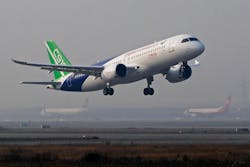How China Stole an Entire Airplane
In April 2018, a Chinese intelligence agent named Xu Yanjun arrived in Belgium. He was there for a clandestine meeting with a GE engineer he believed would sell him confidential aircraft technology belonging to GE Aviation. Instead, Xu was met by a team of Belgian police and FBI agents, put into handcuffs, and escorted to a Belgian prison. His arrest, and a subsequent investigation, uncovered one of the most audacious industrial espionage schemes ever conducted by China.
Xu, a deputy division director in the Chinese spy agency JSSD, was allegedly one of the leaders of a scheme to steal information from U.S. and international firms working with the Commercial Aircraft Corporation of China (COMAC). The Chinese company was already partnering with western firms to design and build a new narrow-body jet, the C919. But with the likely approval of COMAC, China’s spy agency decided to quietly steal the western firms’ respective technologies.
An indictment filed in California on October 25, 2018, charged 10 individuals with conspiring to steal aerospace trade secrets from 13 western companies, most of them U.S.-based. The indictment also revealed that French aerospace manufacturer Safran was infiltrated when employees in its Suzhou, China, office inserted malware into the Safran computer network. This malware gave Chinese agents access to Safran’s confidential files.
According to a detailed report by the U.S. cybersecurity firm Crowdstrike, the espionage operation was run by China’s Jiangsu State Security Division (JSSD). Chinese spies recruited engineers at the partner firms either through appeals to misplaced Chinese patriotism, or bribes, or both. One Chinese agent indicted in October 2018 was a GE engineer named Zhang Zhang-Gui. Zhang had traveled to China and given a lecture to a group of Chinese aerospace engineers. At the talk, he allegedly disclosed confidential GE information for a payment of just $3,500. Zhang had arranged the meeting after telling work colleagues he would be attending a family wedding. He later admitted to the FBI that there was no wedding.
What did COMAC gain from its overall espionage operation? Even with help from its western partners, COMAC has experienced significant difficulties in developing the C919 to a point where it could match the performance of major competitors like Boeing and Airbus. Crowdstrike believes that JSSD’s hacking of the various western aerospace companies allowed COMAC to trim “several years (and potentially billions of dollars) off of its development time.”
The C919 story demonstrates the pitfalls of western companies partnering with Chinese firms. Beijing has repeatedly pledged to halt its industrial espionage campaigns. But it has never actually kept its promises.
China stands alone in the world in the way it engages in broad-based, pervasive industrial espionage through the use of human sources, cyber-intrusion, and outright theft across a countless number of industries. According to U.S. Trade Representative Robert Lighthizer, China’s IP theft costs the US between $225 billion and $600 billion each year. And Senator Chuck Schumer (D-NY) has told this author that China’s repeated hacking of U.S. firms represents “the largest case of theft in the history of the world.”
If there is a thief in your neighborhood who sometimes pays for goods, you don’t try to do more business with him. Until China demonstrates a fundamental strategic change and a willingness to live by globally accepted rules for corporate and intellectual property, the U.S. should continue the tariffs imposed in 2018 by the Trump administration. Until then, the United States should do less business with China, not more.
Jeff Ferry is chief economist at the Coalition for a Prosperous America (CPA).
